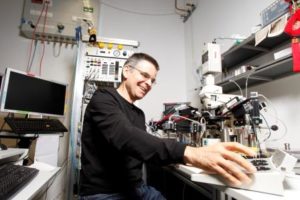Peter Jonas
Magdalena Walz Professor for Life Sciences
Am Campus 1
A-3400 Klosterneuburg
Phone: +43 (0) 2243 9000 3701
Research
I made several discoveries that continuously challenged existing dogmas in neuroscience and changed our way of thinking about synaptic signaling in the brain.
Early in my career, I developed a technique to perform patch-clamp recordings from demyelinated axons. Subsequently, at the time when I worked with the Nobel laureate Bert Sakmann in Heidelberg from 1990 – 1994, I characterized the mechanisms of synaptic transmission at the hippocampal mossy fiber synapse in the CA3 region and the gating of molecularly distinct types of glutamate receptors.
After establishing my independent lab in Freiburg in 1995, I made several contributions to the functional analysis of glutamatergic synapses in the hippocampus. I discovered that interneurons in the hippocampus show rapid excitation from principal neurons, and identified the underlying molecular mechanisms (Geiger et al., 1995; 1997). I also found that AMPA-type glutamate receptors expressed in interneurons are highly permeable to Ca2+. I pioneered the technique of direct recording from presynaptic terminals in the cortex, the hippocampal mossy fiber terminals (Geiger and Jonas, 2000). I found that action potentials in hippocampal mossy fiber boutons show activity-dependent broadening. This paper provided the first indication for analogue coding of information in a mammalian axon. I also discovered that mossy fiber boutons express voltage-gated Na+ channels in high density, leading to a boosting of the amplitude of the presynaptic action potential (Engel and Jonas, 2005). Finally, I was involved in pioneering work that characterized the glutamatergic input synapses of young granule cells in the dentate gyrus generated by adult neurogenesis (Schmidt-Hieber et al., 2004).
I also made several contributions to the field of GABAergic interneuron function. I developed techniques to record from pairs of interneurons and various types of target cells. I discovered that individual interneurons in the spinal cord co-release two fast transmitters, glycine and GABA (Jonas et al., 1998). These results challenged the prevailing dogma that a single neuron only releases a single transmitter. I found that synaptic transmission at interneuron-interneuron synapses is fast, strong, and shunting (Bartos et al., 2002; Bartos et al., 2007). Using a combined experimental-computational approach, I demonstrated that shunting inhibition provides a mechanism to homogenize the firing of interneurons, which greatly increases the robustness of coherent gamma oscillations in interneuron networks. Furthermore, I found that the output synapses of parvalbumin-expressing interneurons show a tight coupling between presynaptic Ca2+ channels and Ca2+ sensors of exocytosis and involve a small number of Ca2+ channels (Hefft and Jonas, 2005; Bucurenciu et al., 2008; Bucurenciu et al., 2010). Both factors contribute to the speed of GABAergic transmission at the output synapses of parvalbumin-expressing interneurons. In contrast, CCK-expressing interneurons show a looser coupling and release transmitters highly asynchronously, suggesting a new form of tonic inhibition (Hefft and Jonas, 2005). Finally, I performed the first direct recordings from the dendrites of fast-spiking, parvalbumin-expressing interneurons (Hu et al., 2010).
In summary, I have pioneered the techniques of subcellular patch clamping and paired recording. I substantially shaped the fields of presynaptic recording and interneuron function. The results were highly influential and changed our way of thinking about the mechanisms of synaptic transmission and dynamics in neuronal microcircuits.
Selected awards
2022 Magdalena Walz Professor for Life Sciences (first named professorship at ISTA)
2021 Peter Seeburg Integrative Neuroscience Prize of the Society of Neuroscience (100,000 $)
2019 Elected member of EMBO
2018 Schrödinger Award of the Austrian Academy of Sciences (ÖAW)
2017 Elected Member of the Dana Alliance for Brain Initiatives (DABI)
2016 Wittgenstein Award of the Austrian Minister of Science, Research and Economy and the Austrian Science Fund (1.5 Mio €)
2015 Elected Member Academia Europaea
2011 David Smith Lecture, Oxford
2011 Adrian Lecture, Cambridge
2009 Adolf-Fick Award, Physicomedical Society, Würzburg
2008–2010 Internal Senior Fellow of the Freiburg Institute for Advanced Studies
2008 Elected Member of the Academy of Sciences, Heidelberg
2007 Tsungming Tu Award, National Science Council of Taiwan (75,000 $)
2006 Szentagothai Memorial Lecture, University of California, Irvine
2006 Gottfried Wilhelm Leibniz Award, German Research Council (1.55 Mio €)
2002 Elected Member of the German National Academy of Sciences Leopoldina
1998 Max Planck Research Award for international cooperation
1997 Medinfar European Prize in Physiology, President of Portugal
1994 Heinz Maier Leibnitz Award, German minister for education and science
1992 Heisenberg Fellowship, German Research Council
1991 Franz Vogt Award, University of Giessen
Selected Publications
- Hu H, Gan J, Jonas P (2014) Fast-spiking, parvalbumin+ GABAergic interneurons: From cellular design to microcircuit function. Science 345:DOI: 10.1126/science.1255263.
- Vyleta NP, Jonas P (2014) Loose coupling between Ca2+ channels and release sensors at a plastic hippocampal synapse. Science 343:665–670.
- Hu H, Jonas P (2014) A supercritical density of Na+ channels ensures fast signaling in GABAergic interneuron axons. Nature Neuroscience 17:686–693.
- Pernía-Andrade AJ, Jonas P (2014) Theta–gamma modulated synaptic currents in hippocampal granule cells in vivo define a mechanism for network oscillations. Neuron 81:140–152.
- Eggermann E, Jonas P (2012) How the “slow” Ca2+ buffer parvalbumin affects transmitter release in nanodomain coupling regimes at GABAergic synapses. Nature Neuroscience 15:20–22.
- Bucurenciu I, Bischofberger J, Jonas P (2010) A small number of open Ca2+ channels trigger transmitter release at a central GABAergic synapse. Nature Neuroscience 13:19–21.
- Hu H, Martina M, Jonas P (2010) Dendritic mechanisms underlying rapid synaptic activation of fast-spiking hippocampal interneurons. Science 327:52–58.
- Bartos M, Vida I, Jonas P (2007) Synaptic mechanisms of synchronized gamma oscillations in inhibitory interneuron networks. Nature Reviews Neuroscience 8:45–56.
- Hefft S, Jonas P (2005) Asynchronous GABA release generates long-lasting inhibition at a hippocampal interneuron–principal neuron synapse. Nature Neuroscience 8:1319–1328.
- Schmidt-Hieber C, Jonas P, Bischofberger J (2004) Enhanced synaptic plasticity in newly generated granule cells of the adult hippocampus. Nature 429:184–187.
Curriculum Vitae
Download full version here.

